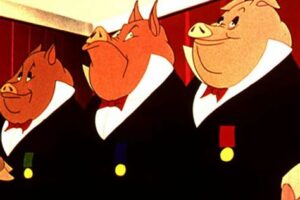Table of Contents
Farm animals contribute to deforestation, water pollution, and greenhouse gas emissions, making them a major threat to the environment.
It’s easy to fall in love with the idea of farm animals roaming freely on green pastures. Yet, the reality is that these four-legged creatures can cause significant harm to the environment. Whether it’s through their waste production or land usage, farm animals have a larger impact than we might expect. For starters, the methane gas produced by cows is a significant contributor to climate change, and the amount of water needed to sustain livestock is staggering. Moreover, the land used to raise animals could be put towards more sustainable practices, such as growing crops that benefit the environment. So, while farm animals might seem idyllic, the truth is that they’re bad news for the planet.
Farm animals have been a part of human civilization for thousands of years. They were initially domesticated for food, clothing, and labor. However, with the growing human population and increasing demand for animal products, the number of farm animals has skyrocketed, causing significant harm to the environment. In this article, we will explore why farm animals are bad for the environment and what we can do to reduce their impact.
Land Use
The rearing of farm animals requires large areas of land for grazing and growing feed crops. This land use comes at a considerable cost to the environment. The clearing of forests and other natural habitats for animal agriculture contributes to deforestation, soil erosion, and habitat loss for wildlife.
Water Resources
The rearing of farm animals requires vast amounts of water to grow and irrigate feed crops and to provide drinking water for animals. This water use has a significant impact on the environment, leading to water scarcity, soil degradation, and pollution from animal waste runoff.
Greenhouse Gas Emissions
The rearing of farm animals is a significant contributor to greenhouse gas emissions. Animal agriculture releases large amounts of methane, nitrous oxide, and carbon dioxide into the atmosphere. These gases trap heat and contribute to global warming, climate change, and extreme weather events.
Air Pollution
The rearing of farm animals leads to air pollution from animal waste, dust, and emissions from transport vehicles. These pollutants can have adverse health effects on both animals and humans residing near these facilities.
Loss of Biodiversity
The rearing of farm animals contributes to the loss of biodiversity by damaging natural habitats and promoting monoculture. The use of pesticides and fertilizers on feed crops also has an adverse impact on pollinators, beneficial insects, and other wildlife.
Animal Welfare
The rearing of farm animals in industrial settings often results in poor animal welfare conditions. Animals are kept in cramped spaces, subjected to stressful conditions, and denied access to natural behaviors. This can lead to animal suffering, illness, and disease outbreaks.
Food Security
The current food system is unsustainable and poses a significant threat to global food security. The rearing of farm animals contributes to this problem by diverting resources away from human food production. The use of feed crops for animal agriculture reduces the availability of food for people and exacerbates food insecurity in low-income countries.
Alternatives to Animal Agriculture
There are several alternatives to animal agriculture that can help reduce its impact on the environment. These include plant-based diets, alternative protein sources such as insects and lab-grown meat, and regenerative agriculture practices that focus on soil health and biodiversity.
The Role of Consumers
Consumers have a significant role to play in promoting sustainable agriculture. By choosing plant-based diets, supporting local and organic farming, and reducing food waste, consumers can help reduce the impact of animal agriculture on the environment.
Conclusion
The rearing of farm animals has a significant impact on the environment, contributing to land use, water resources, greenhouse gas emissions, air pollution, loss of biodiversity, animal welfare, and food security issues. However, there are several alternatives to animal agriculture, and consumers can play a crucial role in promoting sustainable agriculture practices.
Farm animals are often seen as a vital source of food for many people around the world. However, they come at a great cost to the environment. Farm animals, especially cows, contribute to climate change by producing large quantities of methane gas through their digestive processes. Methane is a potent greenhouse gas that traps heat in the atmosphere and contributes to global warming. In addition to this, to make space for grazing land for farm animals, large areas of forests are often destroyed, leading to deforestation. This not only leads to the loss of biodiversity but also adds to the already alarming rate of deforestation.Furthermore, animal waste and manure from farms often end up in nearby water bodies, polluting them with harmful bacteria and causing harmful algal blooms that harm the aquatic life. Overgrazing by farm animals can lead to the erosion of topsoil, the depletion of soil nutrients, and even barren land. This can have a significant negative impact on the ecosystem and cause problems such as soil erosion and desertification. The water consumption rate of farm animals is extremely high, and in areas where water is scarce, it can lead to conflicts between farmers, wildlife, and local communities.Farm animals are often treated with antibiotics to prevent or treat diseases. However, excessive use of antibiotics can lead to antibiotic resistance, making it difficult to treat bacterial infections in humans and animals. Livestock farming requires large amounts of energy for heating, cooling, and lighting. This energy is often produced by burning fossil fuels, leading to the emission of greenhouse gases and negative impacts on the environment. As grazing land for farm animals increases, it often leads to conflicts between farmers and wildlife. This can result in the killing of endangered animals and destruction of habitats.The amount of land required to raise farm animals for meat, dairy, and eggs is much higher than the land required for plant-based agriculture. As the world population grows, this will become an increasingly important issue. The transportation of farm animals from one location to another requires large amounts of transportation fuel, contributing to pollution and climate change. All of these issues are a result of the impact of farm animals on the environment.In conclusion, while farm animals are an important source of food for many people, their impact on the environment cannot be ignored. They contribute to climate change, deforestation, water pollution, soil degradation, water scarcity, antibiotic resistance, energy consumption, wildlife conflicts, land use, and transportation emissions. It is essential to find more sustainable ways to produce food that are not detrimental to the environment. Plant-based agriculture could be a solution to many of these problems, as it requires less land, water, and other resources, and produces fewer greenhouse gas emissions and other environmental impacts. The future of our planet depends on finding more sustainable ways to feed ourselves while protecting the environment for future generations.
There was a time when farm animals were considered a necessary part of our lives. They provided us with food, clothing, and labor. However, in recent times, we have come to realize that farm animals are not as beneficial to the environment as we once thought.
Why Are Farm Animals Bad For The Environment?
There are several reasons why farm animals are bad for the environment. Some of the main reasons include:
- Greenhouse Gas Emissions: Farm animals, especially cows, produce a lot of methane gas. Methane is a potent greenhouse gas that contributes to climate change. According to the United Nations, livestock farming is responsible for 14.5% of global greenhouse gas emissions.
- Water Pollution: Livestock farming is also a major contributor to water pollution. Animal waste and chemicals used in animal feed can contaminate water sources and harm aquatic life.
- Deforestation: To make space for livestock farming, forests are often cleared. Deforestation contributes to climate change by reducing the number of trees that absorb carbon dioxide from the atmosphere.
- Biodiversity Loss: Livestock farming can also lead to the loss of biodiversity. When forests are cleared for farming, the habitats of many wild animals are destroyed.
My Point of View
As an environmentalist, I believe that we need to reduce our reliance on farm animals. This does not mean that we should stop eating meat altogether, but we should consume it in moderation. We should also focus on sustainable farming practices that minimize the negative impact of livestock farming on the environment.
One way to do this is to promote plant-based diets. By consuming more fruits, vegetables, and grains, we can reduce our demand for meat and therefore, reduce the number of farm animals needed to meet our needs.
We should also support farmers who practice sustainable farming methods. These farmers use techniques that minimize the negative impact of livestock farming on the environment. For example, they may use rotational grazing, which allows grass to grow back naturally and prevents soil erosion.
In conclusion, farm animals are bad for the environment because they contribute to climate change, water pollution, deforestation, and biodiversity loss. As individuals, we can reduce our impact on the environment by consuming meat in moderation and supporting sustainable farming practices. Together, we can create a more sustainable future for ourselves and the planet.
Thank you for taking the time to read this article on why farm animals are bad for the environment. It’s important to understand the impact of our food choices on the planet, and animal agriculture is one of the most significant contributors to environmental degradation.
As we’ve discussed, the production of meat, dairy, and eggs requires vast amounts of land, water, and other resources. This not only leads to deforestation and habitat destruction but also contributes to soil erosion, water pollution, and greenhouse gas emissions. In addition, the waste and manure produced by farm animals can contaminate nearby water sources and contribute to air pollution.
While it may be difficult to give up meat entirely, reducing your consumption can have a significant impact on the environment. Consider incorporating more plant-based meals into your diet or choosing meat and dairy products from more sustainable sources. Supporting local farmers who use sustainable farming practices can also make a difference.
In conclusion, we must recognize the impact that animal agriculture has on the environment and take steps to reduce our consumption of animal products. By making small changes in our diets and supporting sustainable farming practices, we can help protect our planet for future generations.
.
As an AI language model, I am here to answer your queries about why farm animals are bad for the environment. Here are some common questions people ask:
-
How do farm animals contribute to climate change?
Farm animals emit a significant amount of greenhouse gases, especially methane and nitrous oxide. These gases trap heat in the atmosphere, leading to global warming and climate change. Additionally, the production of animal feed requires large amounts of fossil fuels, which also contributes to climate change.
-
What impact do farm animals have on water resources?
Farm animals generate a tremendous amount of waste, which can pollute nearby water sources. Their waste contains harmful pathogens and chemicals that can contaminate rivers, lakes, and groundwater. Additionally, the large-scale use of antibiotics in animal agriculture can lead to antibiotic-resistant bacteria that can make their way into our water supply.
-
Why is animal agriculture responsible for deforestation?
The production of animal feed requires vast amounts of land, leading to deforestation in many areas. Clearing forests for grazing land or crops to feed animals releases carbon dioxide into the atmosphere and reduces the earth’s ability to absorb carbon dioxide.
-
How does animal agriculture affect biodiversity?
The destruction of natural habitats for animal agriculture leads to the loss of biodiversity. Livestock grazing and feed production can also lead to soil erosion and nutrient depletion, which negatively affects plant and animal populations.
In conclusion, animal agriculture has a significant impact on the environment in various ways. By reducing our consumption of animal products and supporting sustainable agriculture practices, we can help minimize the negative impact of animal agriculture on our planet.






